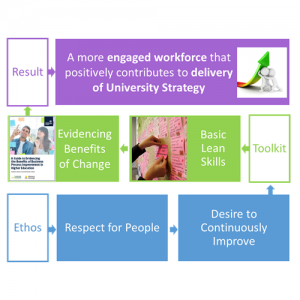Lean seeks to “design out” overburden, inconsistency, and waste in operational processes, but in higher education it is not a rigid concept. The University of Strathclyde embraces lean’s respect for people and continuous improvement ethos, but with an added emphasis on data and evidence, as Heather Lawrence explains.
I started my career in a ‘service development’ role within the public sector. It gave me a solid grounding in a range of techniques that allowed me to deconstruct how we do things in order to identify how we can most effectively improve it. It took almost ten years for me to understand that what I had actually been doing was in fact lean, it was just under a different banner.
In recent years, my thinking has evolved and I’ve learned that data and evidence are also vital components of any transformational change approach. All too often we focus on what we think we should be improving but are we really going after the right solutions?
By taking the time to gather evidence, a change initiative can start from the right footing. Whilst that might not be considered by some to be textbook ‘lean’, adding this twist has had a transformative effect at the University of Strathclyde.
The Business Improvement Team at Strathclyde began embedding a continuous improvement culture in 2013 using the key principles of lean to deliver impactful change against the university’s strategic priorities. In our first year, we focused on a university-wide initiative that delivered significant impact through increased revenues and efficiency savings. In our second year, we focused on localised change initiatives which delivered highly, albeit not on the same scale as the university-wide initiative.
We now have a balance across our improvement portfolio to allow us to support both strategic long-term transformational change, and small to medium scale projects that develops our colleagues to deliver change within a shorter period of time; thus generating a culture of continuous improvement at all levels.
Anyone can adopt a lean approach. In the twelve years that I have been focused on improving institutions from within, how you engage with your colleagues is at the heart of it. A passion for improvement, openness for change, ability to listen to the points of view of others, and the drive to do more than just talk about it is all you need, and this is relevant to anyone regardless of role.
Learning some basic improvement skills such as process mapping, waste identification and standard work, and using these in a visual way can stimulate engagement and buy-in across any change. Our guide to evidencing the benefits of improvements can also help you to incorporate a more benefits-driven approach to your change initiatives.








